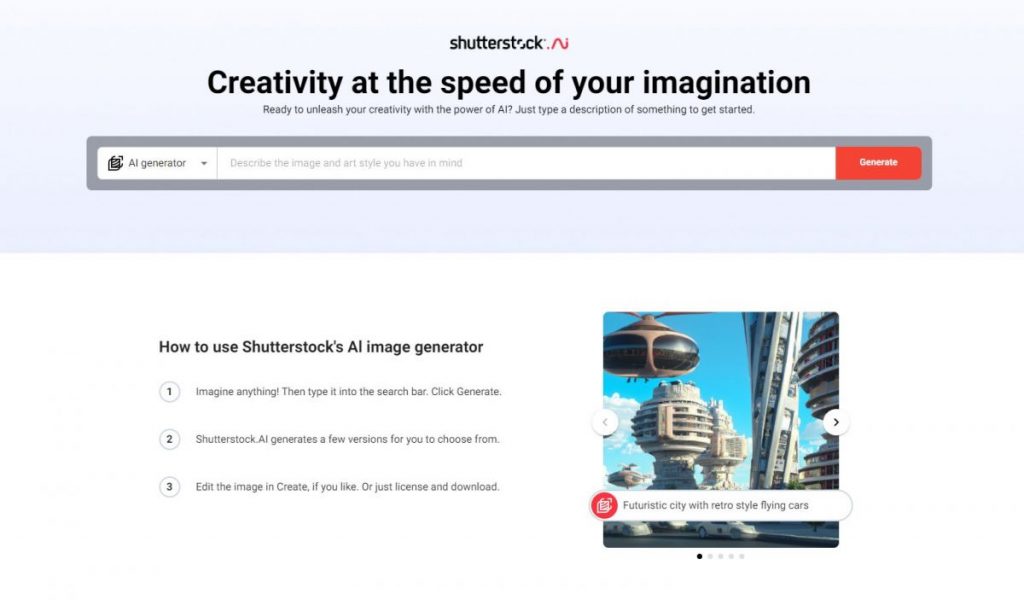Shutterstock has released an AI generator based on Dall-E 2


In Brief
Shutterstock has announced a new artificial intelligence (AI) tool that will help users create unique artwork.
The AI art generator, developed in collaboration with Meta, enables users to create 4 pictures that can be licensed for use.
Shutterstock, an international leader in royalty-free stock photos, vectors, and videos, announced a new artificial intelligence (AI) tool that will help users create unique artwork. The AI art generator, which was developed in collaboration with Meta, enables users to create four pictures that can be licensed for use.

The AI art generator is based on a deep learning algorithm that takes images as input and outputs images that are similar to the input. The user can then select one of the generated images and license it for use.
Shutterstock’s announcement comes at a time when AI is increasingly being used to create artwork. Last year, many AI startups, such as OpenAI, StabilityAI, and Midjourney, released AI tools to generate realistic images.

In 2022, a scandal involving Shutterstock and AI-generated images made headlines. It was revealed that Shutterstock had been banning AI-generated images from its site, even though it had previously promoted them. This created a backlash among some users, who felt that they had been deceived.
In October of 2022, Shutterstock made headlines when it was revealed that the company had been working with OpenAI, a research lab focused on artificial intelligence, on a new project. The project in question was an artificial intelligence system that could generate realistic images of people, places, and things, and Shutterstock planned to use it to create millions of new stock photos.
Also, Shutterstock claimed that the first AI picture generator on the market would pay contributors for their contributions to the generative AI process. When contributors’ content is utilized to create generative models, the company pays them directly through the Shutterstock Contributor Fund.
AI is also being used to create music. The Riffusion project’s team has discovered a really inventive application of AI for image generation in music composition. On spectrogram images showing the frequency and amplitude of a sound wave changing over time, together with a text description, they trained the open Stable Diffusion model.
Read more about AI:
Disclaimer
In line with the Trust Project guidelines, please note that the information provided on this page is not intended to be and should not be interpreted as legal, tax, investment, financial, or any other form of advice. It is important to only invest what you can afford to lose and to seek independent financial advice if you have any doubts. For further information, we suggest referring to the terms and conditions as well as the help and support pages provided by the issuer or advertiser. MetaversePost is committed to accurate, unbiased reporting, but market conditions are subject to change without notice.
About The Author
Damir is the team leader, product manager, and editor at Metaverse Post, covering topics such as AI/ML, AGI, LLMs, Metaverse, and Web3-related fields. His articles attract a massive audience of over a million users every month. He appears to be an expert with 10 years of experience in SEO and digital marketing. Damir has been mentioned in Mashable, Wired, Cointelegraph, The New Yorker, Inside.com, Entrepreneur, BeInCrypto, and other publications. He travels between the UAE, Turkey, Russia, and the CIS as a digital nomad. Damir earned a bachelor's degree in physics, which he believes has given him the critical thinking skills needed to be successful in the ever-changing landscape of the internet.
More articles

Damir is the team leader, product manager, and editor at Metaverse Post, covering topics such as AI/ML, AGI, LLMs, Metaverse, and Web3-related fields. His articles attract a massive audience of over a million users every month. He appears to be an expert with 10 years of experience in SEO and digital marketing. Damir has been mentioned in Mashable, Wired, Cointelegraph, The New Yorker, Inside.com, Entrepreneur, BeInCrypto, and other publications. He travels between the UAE, Turkey, Russia, and the CIS as a digital nomad. Damir earned a bachelor's degree in physics, which he believes has given him the critical thinking skills needed to be successful in the ever-changing landscape of the internet.


















































